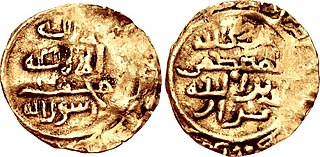
Isma'ilism is a branch or sect of Shia Islam. The Isma'ili get their name from their acceptance of Imam Isma'il ibn Jafar as the appointed spiritual successor (imām) to Ja'far al-Sadiq, wherein they differ from the Twelver Shia, who accept Musa al-Kazim, the younger brother of Isma'il, as the true Imām.

Alamut is a ruined mountain fortress located in the Alamut region in the South Caspian, near the village of Gazor Khan in Qazvin Province in Iran, approximately 200 km (130 mi) from present-day Tehran.

Aga Khan is a title held by the Imām of the Nizari Ismāʿīli Shias. Since 1957, the holder of the title has been the 49th Imām, Prince Shah Karim al-Husseini, Aga Khan IV.

Prince Karim Al-Husseini, known as the Aga Khan IV since the death of his grandfather in 1957, is the 49th and current imam of Nizari Isma'ilis. He has held the position of Imam and the title of Aga Khan since 11 July 1957 when, at the age of 20, he succeeded his grandfather, Aga Khan III. The Aga Khan claims direct lineal descent from the Islamic prophet Muhammad through Muhammad's cousin and son-in-law, Ali, who is considered an Imam by Nizari Isma'ilis, and Ali's wife Fatima, Muhammad's daughter from his first marriage. Aga Khan IV is also known by the religious title Mawlānā Hazar Imam by his Isma'ili followers.

Nizari Isma'ilism are the largest segment of the Ismaili Muslims, who are the second-largest branch of Shia Islam after the Twelvers. Nizari teachings emphasize independent reasoning or ijtihad; pluralism—the acceptance of racial, ethnic, cultural and inter-religious differences; and social justice. Nizaris, along with Twelvers, adhere to the Jaʽfari school of jurisprudence. The Aga Khan, currently Aga Khan IV, is the spiritual leader and Imam of the Nizaris. The global seat of the Ismaili Imamate is in Lisbon, Portugal.

The Khoja are a caste of Muslims mainly members of the Nizari Ismaʿiliyyah sect of Islam with a minority of followers of Sunni Islam originating the western Indian subcontinent, and converted to Islam from Hinduism by the 14th century by the Persian pīr Saḍr-al-Dīn.

Nūr is a term in Islamic context referring to the "cold light of the night" or "heatless light" i.e. the light of the moon. This light is used as a symbol for "God's guidance" and "knowledge", a symbol of mercy in contrast to Nar, which refers to the diurnal solar "hot light" i.e. fire. In the Quran, God is stated to be "the light (Nūr) of the heavens and the earth". Many classical commentators on the Quran compare this to God illuminating the world with understanding, not taken literally. The first and foremost to representatively stand to the concept of nūr muḥammadī being the quintessence of everything was Sayyid Abdul Qadir Gilani, who described this idea in his book Sirr ul Asrar. This concept was then preached by his disciples. One of Sayyid Abdul Qadir Gilani's disciples was the Andalusian scholar Abu Bakr ibn al-Arabi, who categorized nūr into different levels of understanding from the most profound to the most mundane. Shias believe nūr, in the sense of inner esoteric understanding, is inherited through the Imams, who in turn communicate it to the people.
Ginans are devotional hymns or poems recited by Shia Ismaili Muslims.
Satpanth is a Sanskrit term, given to a diverse group of individuals who follow Pir Sadardin. Pir Sadardin Imamshah Bawa, was a Shia Ismaili Da'i who founded the Satpanth Tariqa around 600 years ago, and taught tolerance, perennialism and syncretism of all religions, putting a particular emphasis on the syncretism of Islam and Hinduism.
The Nizari Isma'ilis around the globe are governed by one universal constitution known as "The World Constitution".
The History of Nizari Isma'ilism from the founding of Islam covers a period of over 1400 years. It begins with Muhammad's mission to restore to humanity the universality and knowledge of the oneness of the divine within the Abrahamic tradition, through the final message and what the Shia believe was the appointment of Ali as successor and guardian of that message with both the spiritual and temporal authority of Muhammad through the institution of the Imamate.
Anjudan is a village in Amanabad Rural District, in the Central District of Arak County, Markazi province, Iran. At the 2006 census, its population was 446, in 154 families. it situated near the major Shi'i centres of Qumm and Kashan in Iran, to which the Nizari Ismaili Imamate was transferred during the late 14th century CE. Owing to the village's name, Nizari history between the 14th and 15th centuries is dubbed the "Anjudan period".
In Nizari Isma'ili doctrine imamate is a concept which defines the political, religious and spiritual dimensions of authority concerning Islamic leadership over the nation of believers. The primary function of the Imamate is to establish an institution between an Imam who is present and living in the world and his following whereby each are granted rights and responsibilities.

Ḥasan ʿAlā Zikrihi's-Salām or Hassan II was the hereditary Imam of the Nizari Isma'ilis of the Alamut Period from 1162 until 1166. From his capital of Alamut he ruled parts of Persia and Syria. His chief subordinate in Syria was Rashid ad-Din Sinan, the Old Man of the Mountain.

The Nizari state was a Nizari Isma'ili Shia state founded by Hassan-i Sabbah after he took control of the Alamut Castle in 1090 AD, which marked the beginning of an era of Ismailism known as the "Alamut period". Their people were also known as the Assassins or Hashashins.
Nūr al-Dīn Muḥammad II or ʾAʿlā Muḥammad was the Nizari Isma'ili Imām of Alamūt who reigned the longest period out of any lord (Khudawand) of Alamut, forty-four years. He affirmed the policies of his father, Hassan Ala Dhikrihi's Salam, who had been stabbed to death a year after proclaiming Qiyāma, or Resurrection.
In Nizārī Ismāʿīlism, the qiyāma was ceremoniously proclaimed at the mountain fortress of Alamūt in 1164 CE by the Nizārī imām Ḥasan ʿAlā Dhikrihi al-Salām. According to standard narratives of Islamic eschatology, the Yawm al-Qiyāmah is to take place at the end of time, at which point people will be called to account for their actions, and then be rewarded or punished accordingly. The Nizārī proclamation of qiyāma, however, is distinct in that it takes place within history, and, as such, assumes a special significance.
Abū ʿAlī Ḥasan, or ʿAlī, surnamed Al-Hādī was the 20th Ismaili Nizari Imam. Born in Cairo, he was about 17 years old when his predecessor, Imam al-Mustansir, died, and 20 years old during the assumption of his Imamate in 490 AH/1097 CE. Henceforward, the seat of Ismaili Imamate was transferred from Egypt to Persia owing to the division among the Ismailis, where Hasan bin Sabbah had founded the Nizari Ismaili state.
Al-Qāhir ibn al-Muhtadī bi-Quwwat Allāh or Ḥasan al-Qāhir was the 22nd Imam of the Shia Nizari Ismailis. He is believed to have lived in occultation in the Nizari Ismaili state centrered around Alamut Castle. He is believed to have been represented externally by Kiya Buzurg-Ummid, and later on by Muhammad ibn Buzurg-Ummid.









